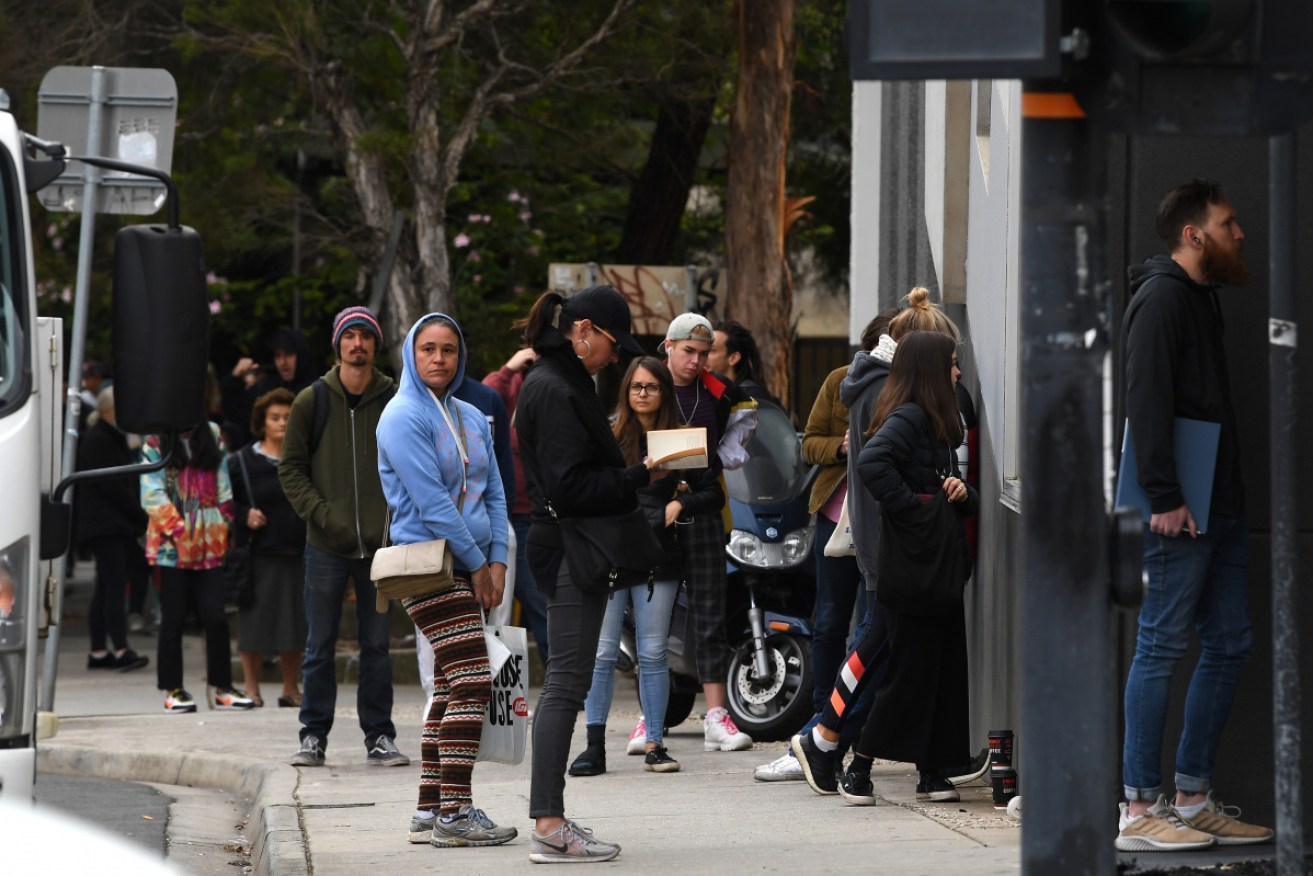Michael Pascoe: The war continues after the immediate battle is won


Scenes such as this outside Centrelink offices were common in late March and early April. Photo: AAP
Full attention is on the immediate COVID-19 battle of flattening the infamous curve – but that won’t mean the end of the health war by any means.
Planning to win the war has to continue at the same time this battle is being fought.
Similarly, the immediate economic battle of extra hundreds of thousands of people suddenly out of work and businesses without customers has captured focus, but there’s a longer war ahead.
The fumbling of this immediate battle – too little fiscal firepower delivered too slowly where it’s needed, the generals’ apparent lack of knowledge of priorities on the frontline – doesn’t instil confidence in the war being short.
An economist friend who prefers to remain anonymous warned me last week that a coming ‘in’ word would be hysteresis.
It means the tendency of effects to linger after whatever caused the effects has passed.
Most obviously, it refers to unemployment to remain after the event that caused the unemployment is over.
“The next step somewhere down the track will be to acknowledge permanent damage,” my tame economist wrote.
“I don’t bank on this being a typical cyclical episode. The only question is how much hysteresis we’ll get.
When will Qantas, for example, get back to anything like its current range of routes. How many Flight Centre shops will reopen? What proportion of restaurants that get shuttered in the next few weeks will ever reopen? Who knows which companies in low-grade bond markets won’t survive?
“We were already on the nose for international tourists because of the bushfires. I see a long, slow slog to get decent growth again – once we get through as difficult a social and economic experience as I can remember.
“A recipe for a cautious, faltering recovery. It’ll be a tough time to be in economic policy.”
Without using the H word, former Treasury Secretary Ken Henry wrote about it in Thursday’s Guardian:
“The immediate economic case for minimising the loss of jobs in a recession is obvious: As workers lose jobs, their incomes fall, they consume less, and other businesses also shed workers. Without government action to boost demand, a vicious cycle is established.
“But there is also a longer-term consequence. In past recessions, many who lost their jobs were never able to find another, even years later.
“In the recession of the early 1980s the unemployment rate almost doubled, increasing from 5.5 per cent to 10.5 per cent in two years. The number of unemployed Australians increased by 330,000.
“An equivalent proportion of today’s workforce would be about 650,000. It took six and a half years, to the end of the 1980s, for the unemployment rate to claw its way back to somewhere close to where it started.
“And there were other, deeper, consequences. During the recession of the early 1980s, the proportion of Australian males with a job fell by about 7 per cent. In the subsequent recovery only half of that fall was reversed. And then Australian workers were hit with the recession of the early 1990s. Over the next three years, the proportion of males with a job fell by a further 10 per cent.
“By the time of the collapse of Lehman Brothers in mid-September 2008 the Australian economy had enjoyed an extraordinary 16-year expansion. Yet after all those years of growth, the proportion of Australian males with a job was only a little above where it was at the low point of the early 1980s recession. Think about that for a moment.”
GFC firepower
It was thinking about that experience that made Australia’s response to the GFC radically different from government response to any previous shock.
“During the GFC, the proportion of Australian males with a job fell only a little, from 69.8 per cent to a low of 67.8 per cent. By the start of 2011, it stood at 69.4 per cent,” Dr Henry wrote.
“Outcomes for females were better. In September 2008 55.8 per cent of females had a job. That proportion never fell below 55.2 per cent during the global financial crisis.”
That’s what massive success in handling an economic crisis looks like.
As Dr Henry warns, the headline unemployment percentages only tell part of the story. Hours worked fell and part-time work rose, but that’s still an excellent outcome.
The lack of radical action to prevent those obscene lines outside Centrelink bodes ill for the immediate battle and, therefore, the course of the war.
The government’s idea of supporting small and medium businesses to keep on workers was good, but the execution was piddling in size and unrealistic in expected impact.
Apprentices and trainees aside, there was no incentive to actually keep workers on after grabbing the tax that had been withheld.
Employers without cash flow simply can’t keep paying out wages.
And, as has been rapidly demonstrated, it’s not just SMEs, as major corporations shed tens of thousands of jobs.
Serious government subsidies for retaining workers – as some countries are doing – was dismissed by the Prime Minister as being “dangerous”.
He did not explain what he thought was dangerous about it.
The danger in letting unemployment blow out to double figures shouldn’t need explaining, but apparently it does to this generation of policy makers.








